Mango is an Indian fruit that originated thousands of years ago in India. It is also known as an ancient sacred fruit and has spread gradually worldwide. A mango’s native land is south Asia, known as the “Common Mango” or “Indian Mango.” Mango is one of the world’s most widely cultivated fruits. Indians consider mangoes to be a symbol of friendship.
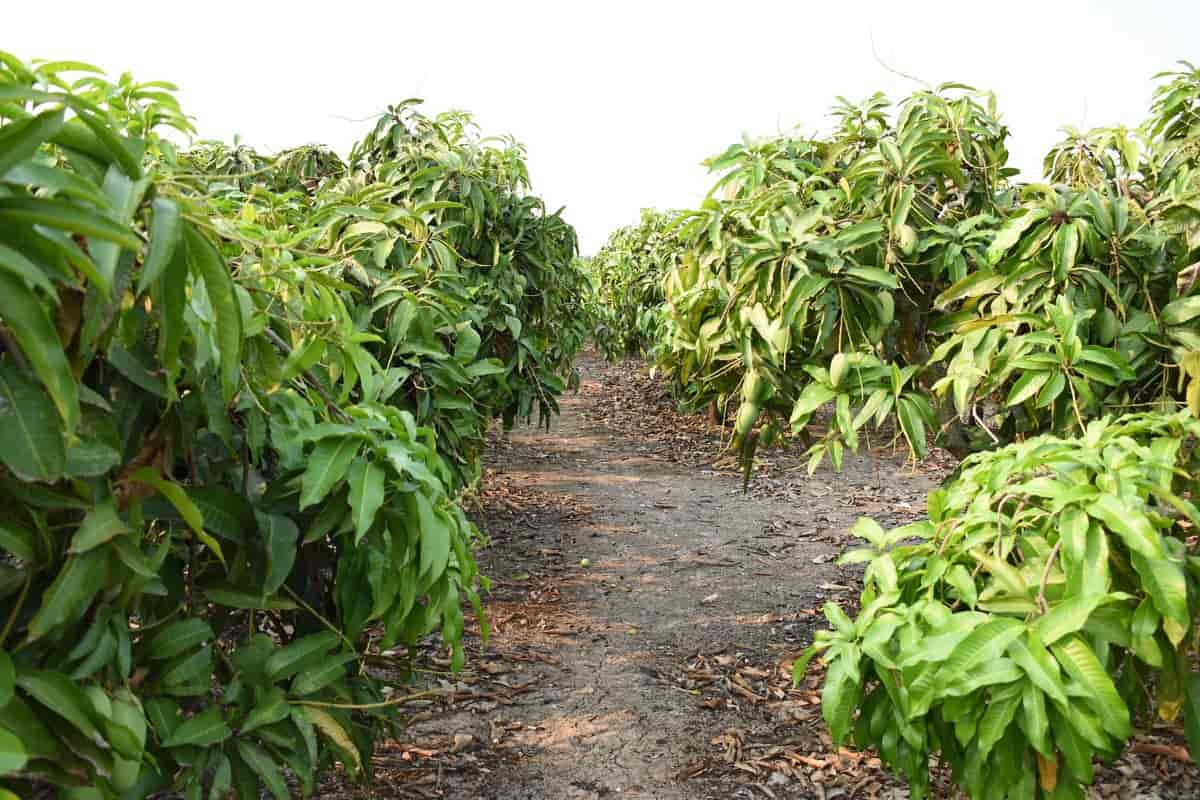
India’s mango industry is one of its most important commercial crops. As we all know, the mango is the king of fruits because of its excellent flavor, attractive fragrance, and delicious taste. In addition, mango trees require little maintenance and are hardy. This fruit’s taste and health benefits make it the sweetest in the world.
Banganapalli mango farming in India
Banginapalli mango
- Bangenpalli Mango is one of the most widely grown varieties of mangoes. Bangenpalli mango or banesha mango is India’s most loved and best mango variety.
- Bangenpalli mango stands first for its sweet fragrance and delicious flavor with enriched nutrients. Bangenpalli mangoes are sourced from Andhra Pradesh and are known for their unique these mango taste is aromatic flavor pulp.
- The Bangenpalli mango trees are medium to large, ranging between 12 to 43 meters in height.
- They are evergreen with large, symmetrically round awnings with an average diameter of 12 meters with dark brown bark.
- Mango has high levels of fiber-rich in Vitamin C and pulp with high Vitamin A.
- Trees are medium in vigor, spreading with a rounded top. Fruit size medium to large (300 to 450g.), beakless. Skin thin and smooth, yellow in color, flesh firm and fibreless, good quality fruit. Stone has few hairs all over. TSS varies between 17-18%. Under Punjab conditions, fruits ripen in July.
- The fruit is predominantly cultivated in Bangenpalli, Paanyam, and Nandyal Mandals of Kurnool district and Chittoor and Kadapa.
- Additionally, the Andhra Pradesh government listed Khammam, Mahbubnagar, Rangareddy, Medak, and Adilabad districts in neighboring Telangana as secondary centers of origin.
Soil and climate requirements for Bangenpalli mango
Climate and soil are both important factors in determining a mango crop’s success or failure. Therefore, these two factors are of utmost importance before establishing a mango orchard. Mangos are grown across the country in various soil and climatic conditions. Thus, when planning a mango orchard, soil samples should be taken and analyzed for pH, nutrient status, EC, and water-soluble salt content. It is also crucial to consider the climatic conditions, temperature, rainfall, wind, hailstorms, and altitude of a given location, especially when selecting a variety.
In case you missed it: A Guide to Understanding Mango Tree Propagation: From Seed, Cuttings, Grafting, and Budding
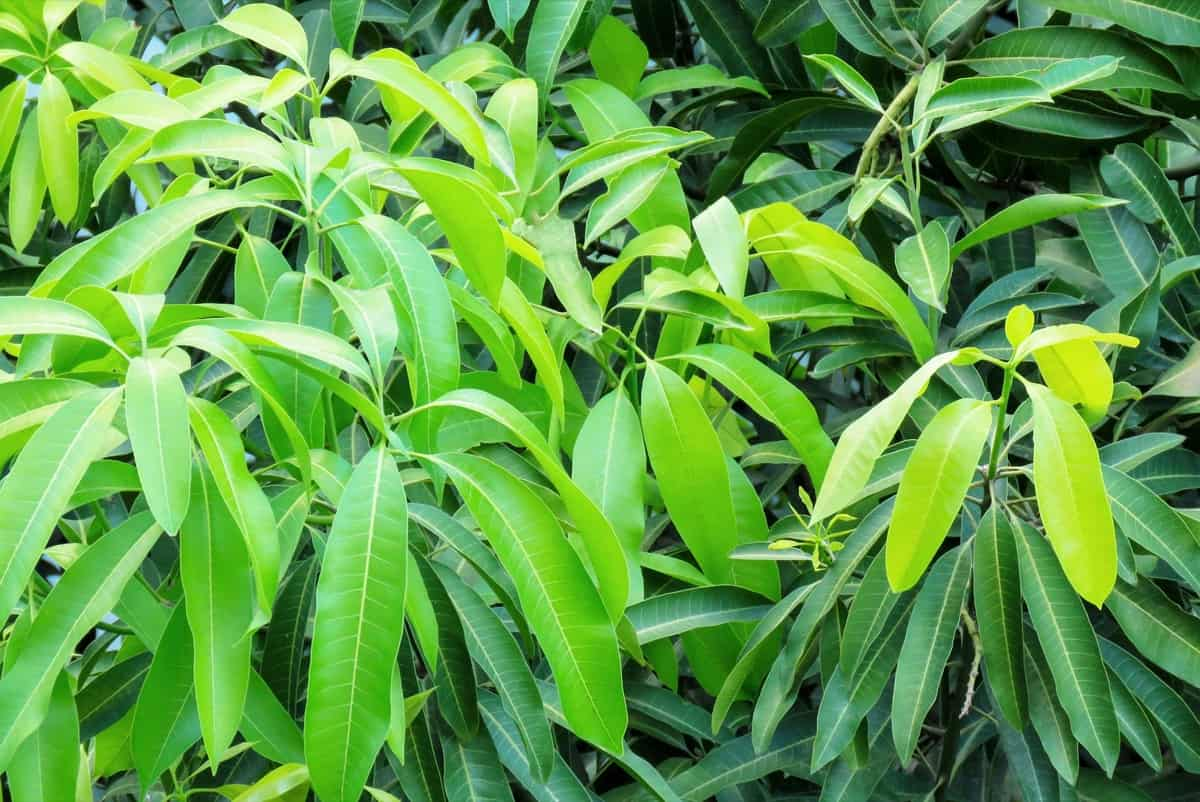
Soil
A mango tree’s vigor and cropping behavior are affected by its soil type. A variety of soil types can be used for growing the Bangenpalli mango. It is best to avoid poorly drained soils. Soils with a pH greater than 7.8 are not suitable for mango growing. Mango orchards grow best in alluvial soils with a pH between 5.5 and 7.5 and a good amount of organic matter. High-quality fruits are produced in soils containing 5 to 10 percent lime and sufficient iron peroxide.
Climate and Temperature
Tropical and subtropical conditions are both suitable for mango cultivation. Consequently, it is resistant to a variety of climatic conditions. In the absence of rainfall, mango trees flower, and bear fruit. Rain or cloudy weather causes considerable damage to mango at the flowering time as it adversely affects flowering and fruit set. A clearly defined range of temperatures and rainfall is required for mango cultivation to be commercially profitable.
Depending on the temperature, it can grow as low as 0°C or as high as 46°C. It thrives best at a temperature around 27°C, however. From June to October, it needs good rainfall; from November onwards, it needs rainless, dry weather. It grows well in areas with low (25 cm) and high (250 cm) rainfall. With an annual rainfall of around 75 cm, it does not require irrigation. Powdery mildew disease and leafhoppers are more likely to occur during rainy or cloudy weather during flowering.
Soil preparation for Bangenpalli mango farming
Apply 300 grams of fertilizer containing phosphorus, potassium, trace elements, or well-rotted animal manure before planting. Mix with topsoil and place in the planting hole. The hole should be filled with topsoil, and the trees should be planted deep enough to cover their root balls completely. You can prevent air pockets by backfilling with sand. However, it may not be practical for large plantings. The soil should be watered before planting has resulted in the successful establishment in these cases.
Plant spacing and sowing time for Bangenpalli mango trees
The spacing between mango trees determines how many trees are needed. In addition to yield and growth, mango spacing affects the management practices in an orchard. Planting mango trees in blocks or densely will provide natural protection from the wind, however, avoid planting them too close together as they will compete for light, water, and nutrients. In addition, too close spacing may severely limit fruit production in mature mango trees, which bear fruit at the ends of branches.
August-September is the best time for planting, followed by February-March. The best period to plant is in the evening during the cool hours. Make sure crops are protected from high winds. In dry zones with little growth, spacing varies from 10 meters x 10 meters to 12 meters x 12 meters in heavy rainfall areas with rich soils. Plant grafted varieties in a square system at a distance of 9m x 9m.
In case you missed it: A Step-By-Step Guide to High Density Fruit Farming: For Guava, Banana, Mango, Pineapple, Lemon, Papaya, Litchi, and Apple
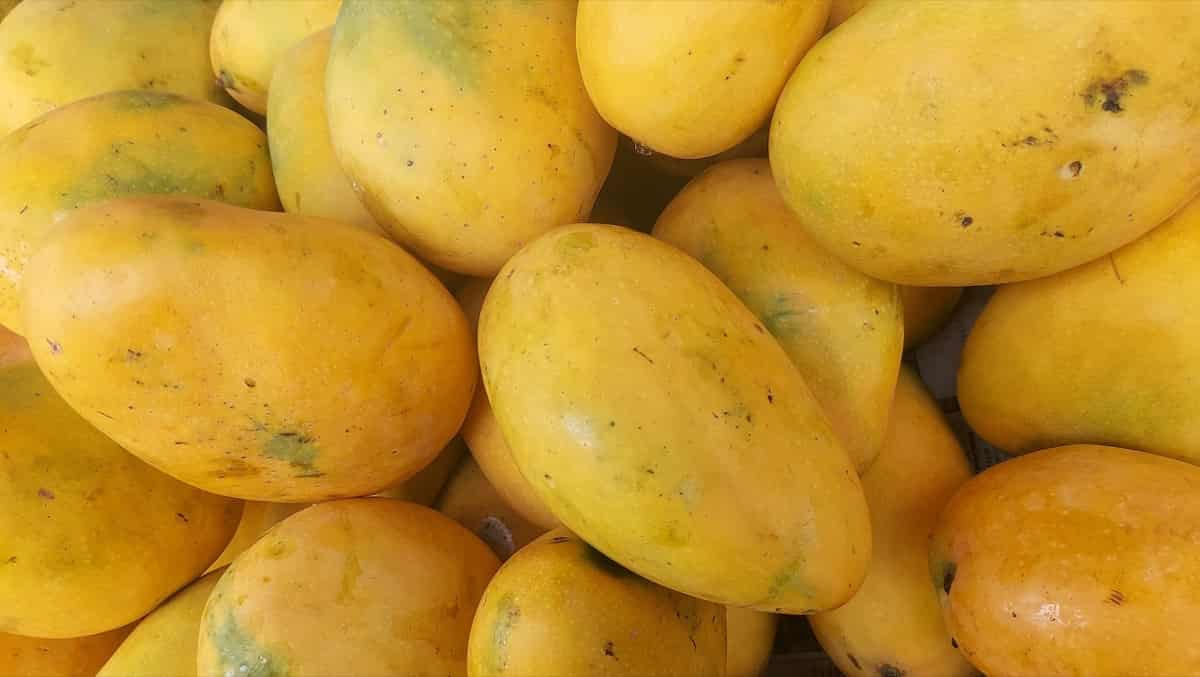
Planting Bangenpalli mango trees
Plant mango trees as seedlings or grafted plants when they are 4-18 months old. Nursery plants should only be lifted if they are well-sized and healthy. The earth ball mustn’t break during transportation. The plants should be packed in 30 X 15 cm plastic bags from distant nurseries. The lifted earth ball may be placed in each bag with quality soil and Farm Yard Manure mixture. The earth balls are better wrapped in this than in trash or grass.
The plants should be packed in containers (plastic/wooden) or crates if polythene bags are unavailable. As a result, earth balls will be less likely to break during transportation. A gentle slope should be maintained for good drainage after deep plowing, harrowing, and land leveling. Prepare pits of 1x1x1m size one month before planting at a distance of 9x9m. Make sure they are exposed to the sun. Fill with soil, 30 to 40 kilograms of farmyard manure or compost, and 1 kilogram of single super phosphate.
In addition, 100 grams of 10 percent chlordane dust are mixed in the pit to prevent termite attack. After planting, plants should be irrigated immediately. You should shade the young plants and stake them for the first one or two years to ensure straight growth. Place the earth ball in the center of the pits after removing the packing material gently. Earth balls should be level with the soil on the field at their upper surface. Ensure the prepared pits are not too high or too low before planting the plants.
The sides of the newly-planted plants should be gently pressed without pressing the original earth balls. Natural materials like leaf litter, hay, bagasse, and composted manure should be mulched around the tree’s base to conserve moisture and suppress weeds. The mulch should not touch the trunk to reduce disease risk. Black polyethylene mulch will reduce water requirements and control weeds when planted on trickle irrigation. Adding natural mulch to a hot area can help reduce heat absorption.
Care of the young plants
Light irrigation should be provided four to seven days a month. For the first year, wooden stakes with lower portions dipped in coal tar can protect the grafts from damage from high-velocity winds. After one month of planting, mix chlorpyriphos 10 ml/liter into a solution and apply it to each plant. The plant is recommended to be treated again in September for the first three years of its life.
Mango crop care
Irrigation for Bangenpalli mango trees
Young plants need water to survive. There is a better result with light and frequent irrigations than flooding after long intervals, and irrigation intervals depend on the soil type, climate, and source of irrigation. In summer, young mango plants should be irrigated every 5-7 days to keep them at field capacity. As winter approaches, gradually increase this interval to 20 days. Avoid irrigation during the rainy season.
In case you missed it: Mango Farming in Mexico: How to Start, Planting to Harvesting, and Production Guide
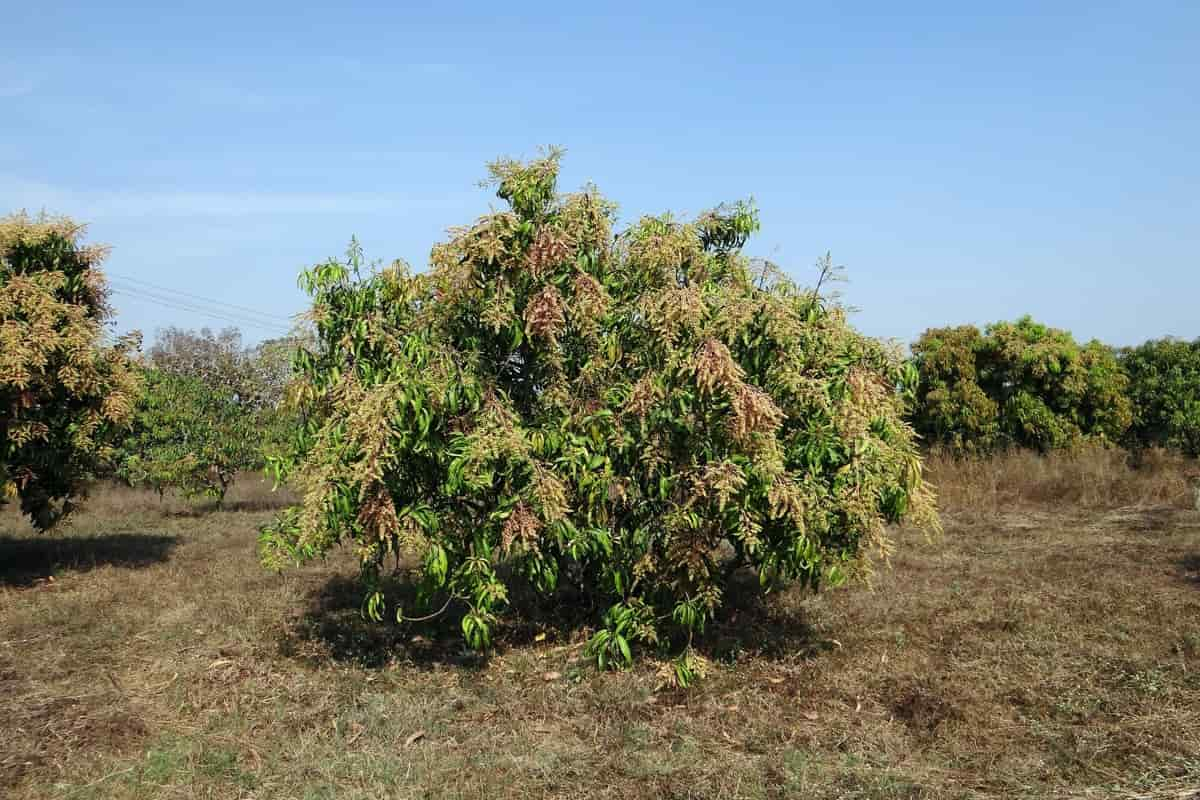
During April, when wheat does not require irrigation, provide a separate irrigation system for the mango plants if intercrops are grown. In North Indian conditions, bearing trees should be irrigated one week before flowering and after fruit set. In winter, irrigation intervals may exceed 25-30 days. From April to October, moist conditions should be maintained.
Training and pruning
Rootstock sprouts and low-lying branches have to be removed. Remove overlapping, intercrossing, diseased, dried, and weak branches in old trees to get good sunlight and aeration. For the internal branches, pruning may be done from August to September, once in three years. Flowering should not be allowed for up to three years. Among crowded terminal shoots, weak shoots are trimmed to retain two healthy shoots during August-September annually.
Weed management
Mangoes are crucial to their growth during the first three to four years following transplanting. Applying organic manure and inorganic fertilizers, irrigation at regular intervals, and good sunshine will grow a broad spectrum of grassy and broad-leaf weeds in mango fields. Therefore, in the cultivation of mango orchards, at least twice a year is necessary to keep the weeds under check, which otherwise may prove harmful to the growth and productivity of mango trees.
When trees are young, the sunlight received at the ground level is more, resulting in the growth of perennial grassy weeds. The weed control in mango orchards for 24 weeks is done using an algicide, DCMU (3-(3,4-dichlorophenyl)-1,1-dimethylurea), as pre-emergent treatment at 3.6 kg per acre. Bromacil and 2,2-Dichloropropionic acid also effectively controlled dicot and monocot weeds, respectively.
In addition, the leaf nitrogen content in young mango seedlings can be increased with Fluchloralin when applied pre-emergent to weeds. One spray of atrazine or DCMU at 0.8 kg a.i./acre as a pre-emergent treatment to soil and one spray of paraquat as a post-emergent spray on weeds at 1.2 kg a.i./acre, six months after the soil treatment, to be effective for controlling both monocot and dicot weeds for one.
Fertilisation for Bangenpalli mango tree
The Bangenpalli mango tree does not require constant care or watering. The first fertilizing of the soil before planting the Bangenpalli mango tree is the most important factor to check. Make a soil mix with topsoil, cow manure, 2kg of bone meal, and 2kg of phosphate, fill the hole, and plant the tree in this mixture.
Nitrogen, Phosphorus, and Potassium mean NPK factors have to be followed.
- One hundred grams of nitrogen, 50 grams of phosphorus, and 100 grams of potassium are required during the first year of the Banginapalli plant.
- In the second year, give the plant 200 grams of nitrogen and potassium and 100 grams of phosphorus.
- And after every year, adds more than 100 grams to the last year’s quantity to increase fertilization.
- Natural fertilizers such as cow manure, compost, and other kinds can be added to this Banganpalli to preserve the soil’s natural traits.
Intercrops
After planting, remove inflorescence for better vegetative growth for up to four years, and at the age of five, keep inflorescence for fruit formation. During this period, intercrop can be taken as it helps to give additional income and also helps to reduce weed growth. Onion, tomato, Radish, Beans, Cabbage, Cauliflower, Moong, gram, Lentil, Peach, Plum Papaya, etc. crops can be taken as intercrop.
In case you missed it: Mango Farming in USA: Growing Regions, How to Start, Planting to Harvesting Guide
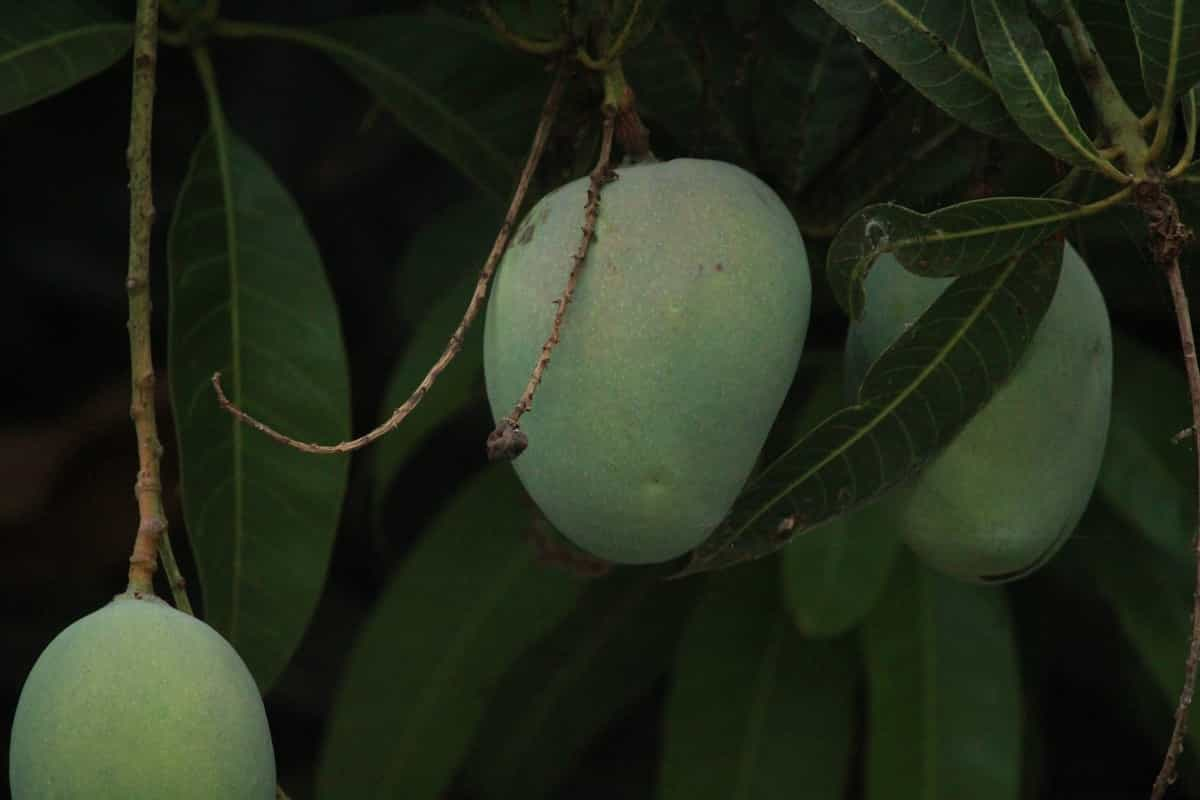
Diseases in Bangenpalli mango
| Diseases | Symptoms | Control methods |
Anthracnose | It produces leaf spots, blossom blight, wither tip, twigs blight, and fruit rot. Small blister-like spots develop on the leaves and twigs. Young leaves wither and dry. Tender twigs wither, and die-back symptom appears. Affected branches ultimately dry up. Black spots appear on fruits.The fruit pulp becomes hard, cracks, and decays at ripening. Infected fruits drop. | Several fungicides are registered from the control of anthracnose, including mancozeb, copper (copper hydroxide, copper oxide, copper oxychloride, or copper sulfate), prochloraz, or azoxystrobin. Post-harvest dips in fungicide (e.g., carbendazim) and hot water (both treatments are for 5 minutes at 52°C) control fruit infections, preventing storage rots. If using carbendazim, allow 3 liters of dip per kilogram of fruit. |
Powdery mildew | A whitish powdery growth appears on inflorescences. The infected floral parts show necrotic streaks and eventually drop. Flowers and fruits affected by the disease drop prematurely, reducing crop load considerably or preventing fruit set. The fungus parasitizes young tissues throughout the inflorescence, leaves, and fruits. | Sprays of wettable sulfur or sulfur dust provide reasonable control of powdery mildew but may cause burn to flowers and young fruit where sprays are applied during sunny, warm conditions. Spray with a fungicide that contains meptyl dinocap as an active ingredient at 1.0 gm/liter. Repeat the spray after 20 days. Give another spray if the powdery mass is seen on young fruits and their pedicles. |
Bacterial black spot | The leaves are initially covered with small black spots and water-soaked lesions. The veins limit these spots, which are surrounded by chlorotic margins. Defoliation occurs as the disease progresses, as the spots dry up and leaves shed. A severely infected fruit might fall off, while an infected fruit has a lower quality. A tree’s stability can be compromised by blackened and cracked branches and stems caused by lesions. | Cut and burn the affected branches and apply Bordeaux paint on the cut ends. Spray Bordeaux mixture 2:2:250 in April, July, and August. Spraying copper oxychloride products has been proven to prevent and decimate infections. Bacteria can also be reduced by biocontrol agents such as Acinetobacter baumannii on infected trees. Benzimidazole and thiophanate-methyl sprays can control mango black spots caused by bacteria. |
Sooty mold | A black velvety coating on the leaf surface indicates the presence of sooty mold in the field. The twigs and leaves of trees can turn completely black due to mold over the entire surface. | Spraying insecticide followed by spraying with fungicide viz., Bordeaux mixture 1% is also recommended. Wettable sulfur methyl parathion+gum acacia (0.2+0.1+3%) at 15-day intervals reduces the sooty mold incidence. |
In case you missed it: Mango Farming in Philippines: How to Start, Varieties, Planting, Care, and harvesting
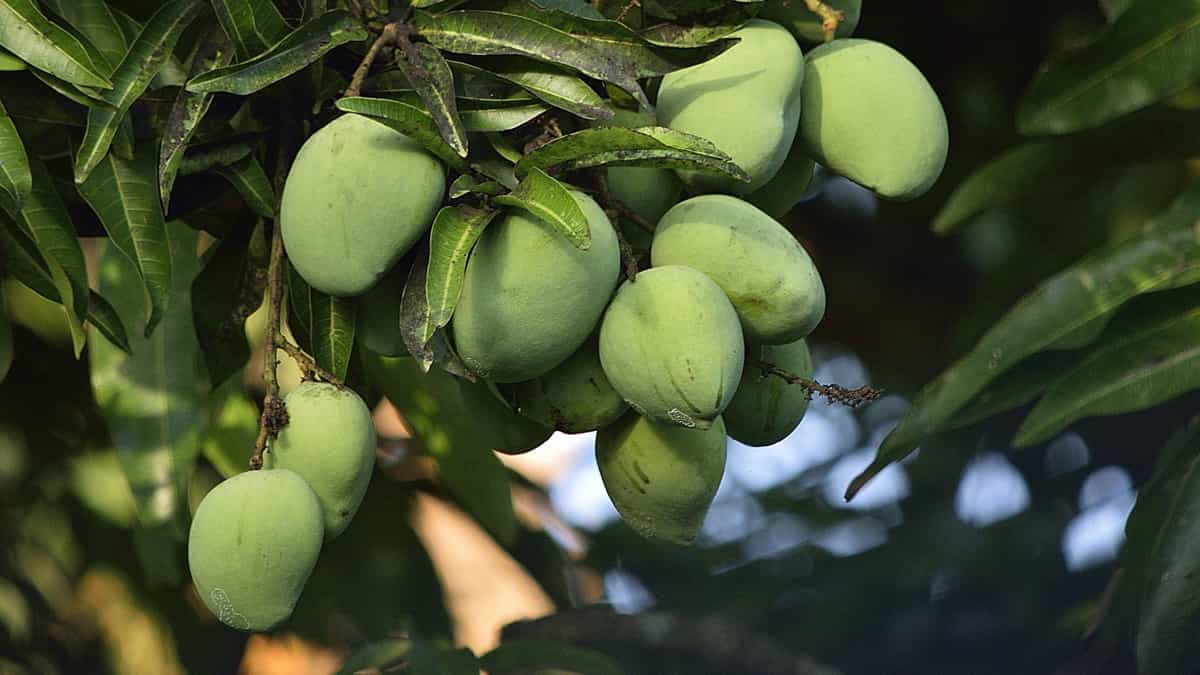
Pests and their management
| Mango pests | Symptoms | Control methods |
Mango hopper | As nymphs and adults, the wedge-shaped insects puncture and soak up sap from tender parts, reducing the strength of plants and especially destroying inflorescences and fruit. Heavy puncturing and continuous draining of sap cause curling and drying of infested tissue. They also damage the crop by excreting a sweet sticky substance that facilitates the development of sooty mold | Wettable sulfur at two g/lit may be sprayed after spraying carbaryl to avoid mite resurgence. The mixture of toxaphene with sulfur (1:1) has been reported to be effective against these pests. Neem oil 5 ml/lit of water can be mixed with insecticides. Spray 3 percent neem oil or neem seed kernel powder extract 5 percent. |
Mango mealybugs | The adult bugs are covered with whitish powder and colonize between the bark of tree trunks, young shoots, and panicles. The nymphs” ascend the trees and settle on inflorescence causing flower drop, affecting fruit set. Honeydew is also excreted by them, which promotes the growth of sooty mold. | Burlap bands reduced the population of mango mealy bug nymphs by 78.98%. Methyl eugenol traps were extremely effective in trapping and killing mealybugs. Stem injection could achieve a very high level of mortality by sucking insects If necessary, apply chlorpyrifos 20 EC 2.5 ml/l |
Fruit fly | Females puncture the outer walls of mature fruits with their pointed ovipositors and insert eggs into small clusters inside their mesocarps. As the larvae hatch, they feed on fruit pulp, and the infected fruits begin to rot. | Bait spray – combing any one of the insecticides and molasses or jaggery 10 g/l,Malathion 50EC 2 ml/l,Dimethoate 30 EC 1 ml/l,Carbaryl 50 WP 4 g/l. Two rounds at two weeks intervals before the ripening of fruits is recommended. |
Conclusion
With increased technology, better-growing practices, and a global market, these fruits are exported worldwide today, and farmers are making more money. Rather than planting 40 mango saplings on one acre as in traditional farming, farmers practice high-density mango farming, which produces a higher yield and around 2-3 tonnes per acre, while high-density farming can produce 9-10 tonnes per acre.
- Economical Aquaculture: A Guide to Low-Budget Fish Farming
- 15 Common Planting Errors That Can Doom Your Fruit Trees
- How to Make Houseplants Bushy: Effective Tips and Ideas
- Innovative Strategies for Boosting Coconut Pollination and Yield
- Pollination Strategies for Maximum Pumpkin Yield
- The Complete Guide to Chicken Fattening: Strategies for Maximum Growth
- Natural Solutions for Tulip Problems: 100% Effective Remedies for Leaf and Bulb-Related Issues
- Revolutionizing Citrus Preservation: Towards a Healthier, Greener Future
- Natural Solutions for Peony Leaf and Flower Problems: 100% Effective Remedies
- Maximizing Profits with Avocado Contract Farming in India: A Comprehensive Guide
- Natural Solutions for Hydrangea Problems: 100% Effective Remedies for Leaf and Flowers
- The Ultimate Guide to Choosing the Perfect Foliage Friend: Bringing Life Indoors
- From Sunlight to Sustainability: 15 Ways to Use Solar Technology in Agriculture
- The Ultimate Guide to Dong Tao Chicken: Exploring from History to Raising
- The Eco-Friendly Makeover: How to Convert Your Unused Swimming Pool into a Fish Pond
- Mastering the Art of Delaware Chicken Farming: Essentials for Healthy Backyard Flocks
- 20 Best Homemade Fertilizers for Money Plant: DIY Recipes and Application Methods
- How to Craft a Comprehensive Free-Range Chicken Farming Business Plan
- Brighten Your Flock: Raising Easter Egger Chickens for Beauty and Bounty
- How to Optimize Your Poultry Egg Farm Business Plan with These Strategies
- Subsidy for Spirulina Cultivation: How Indian Government Schemes Encouraging Spirulina Farmers
- Ultimate Guide to Raising Dominique Chickens: Breeding, Feeding, Egg-Production, and Care
- Mastering the Art of Raising Jersey Giant Chickens: Care, Feeding, and More
- Ultimate Guide to Raising Legbar Chickens: Breeding, Farming Practices, Diet, Egg-Production
- How to Raise Welsummer Chickens: A Comprehensive Guide for Beginners
- How to Protect Indoor Plants in Winter: A Comprehensive Guide
- Ultimate Guide to Grow Bag Gardening: Tips, Tricks, and Planting Ideas for Urban Gardeners
- Guide to Lotus Cultivation: How to Propagate, Plant, Grow, Care, Cost, and Profit
- Agriculture Drone Subsidy Scheme: Government Kisan Subsidy, License, and How to Apply Online
- Ultimate Guide to Raising Araucana Chickens: Breed Profile, Farming Economics, Diet, and Care
- Bringing Hydroponics to Classroom: Importance, Benefits of Learning for School Students
- Ultimate Guide to Raising Polish Chickens: Breed Profile, Farming Economics, Diet, and Care
- Ultimate Guide to Raising Australorp Chickens: Profile, Farming Economics, Egg Production, Diet, and Care
- Silkie Chicken Farming: Raising Practices, Varieties, Egg Production, Diet, and Care
- Sussex Chicken Farming: Raising Practices, Varieties, Egg Production, Diet and Care
- Homemade Feed Formulations for Livestock: Discover Cost-effective Starter to Finisher Feed Recipes